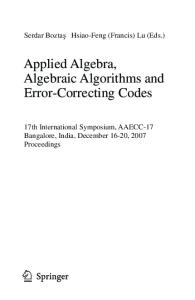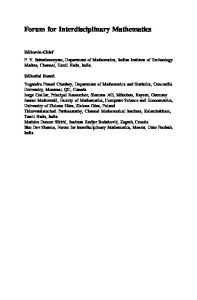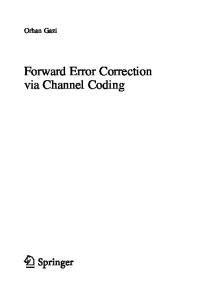LDGM Codes for Channel Coding and Joint Source-Channel Coding of Correlated Sources
- PDF / 811,648 Bytes
- 12 Pages / 600 x 792 pts Page_size
- 88 Downloads / 390 Views
LDGM Codes for Channel Coding and Joint Source-Channel Coding of Correlated Sources Wei Zhong Department of Electrical and Computer Engineering, University of Delaware, Newark, DE 19716, USA Email: [email protected]
Javier Garcia-Frias Department of Electrical and Computer Engineering, University of Delaware, Newark, DE 19716, USA Email: [email protected] Received 2 October 2003; Revised 3 October 2004 We propose a coding scheme based on the use of systematic linear codes with low-density generator matrix (LDGM codes) for channel coding and joint source-channel coding of multiterminal correlated binary sources. In both cases, the structures of the LDGM encoder and decoder are shown, and a concatenated scheme aimed at reducing the error floor is proposed. Several decoding possibilities are investigated, compared, and evaluated. For different types of noisy channels and correlation models, the resulting performance is very close to the theoretical limits. Keywords and phrases: channel coding, LDPC codes, LDGM codes, iterative decoding, correlated sources, joint source-channel coding.
1.
INTRODUCTION
The introduction of turbo codes [1] and low-density parity check (LDPC) codes [2, 3, 4, 5] has been one of the most important milestones in channel coding during the last years. Provided that the information block lengths are long enough, performance close to the Shannon theoretical limit can be achieved for different channel environments. However, in practical applications, complexity issues have to be carefully considered, since both schemes present either high encoding or high decoding complexity. Specifically, for the case of turbo codes the encoding complexity is very low, but the decoding complexity is high. Compared with turbo codes, standard LDPCs present a higher encoding complexity, but the decoder is simpler. In this paper, we first show that it is possible to achieve a channel coding performance comparable to that of standard This is an open access article distributed under the Creative Commons Attribution License, which permits unrestricted use, distribution, and reproduction in any medium, provided the original work is properly cited. This work was partially supported by NSF Grant CCR-0311014 and prepared through collaborative participation in the Communications and Networks Consortium sponsored by the US Army Research Laboratory under the Collaborative Technology Alliance Program, Cooperative Agreement DAAD19-01-2-0011. The US Government is authorized to reproduce and distribute reprints for Government purposes notwithstanding any copyright notation thereon.
LDPC and turbo codes by utilizing systematic linear codes with low-density generator matrices [6] (LDGM codes1 ). LDGM codes present a complexity advantage over standard LDPC and turbo codes. Specifically, because of the sparseness of the generator matrix, the amount of processing required in the encoder is linear with the block size and similar to that of turbo codes. Moreover, since the parity check matrix of systematic LDGM codes is also sparse,
Data Loading...











